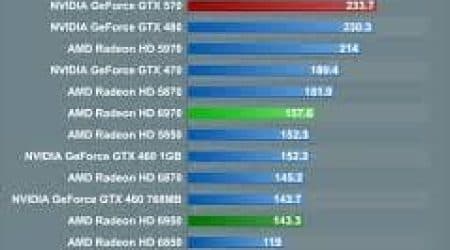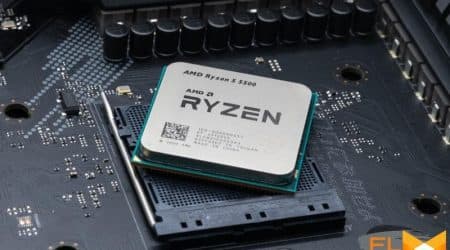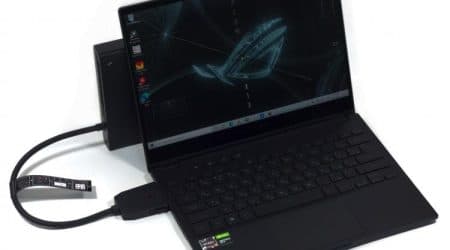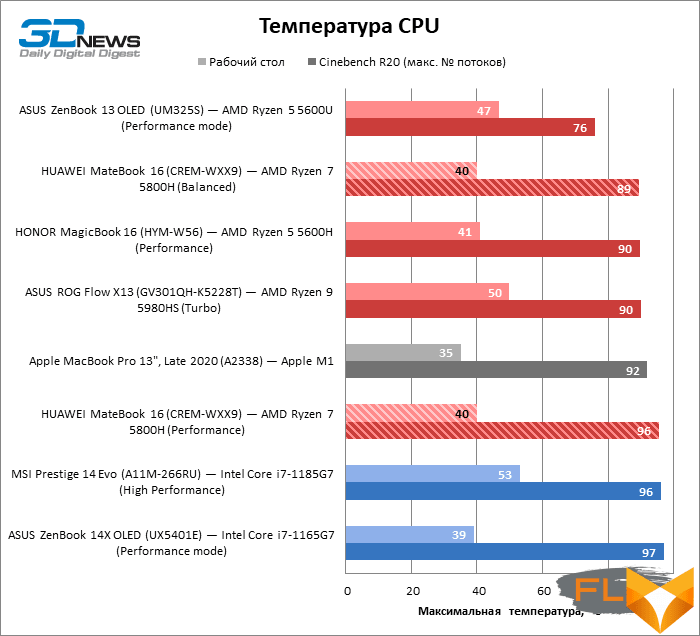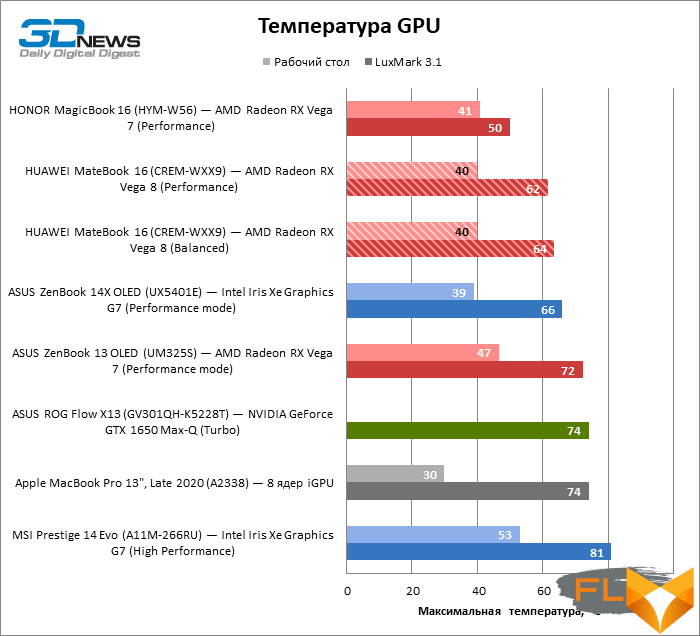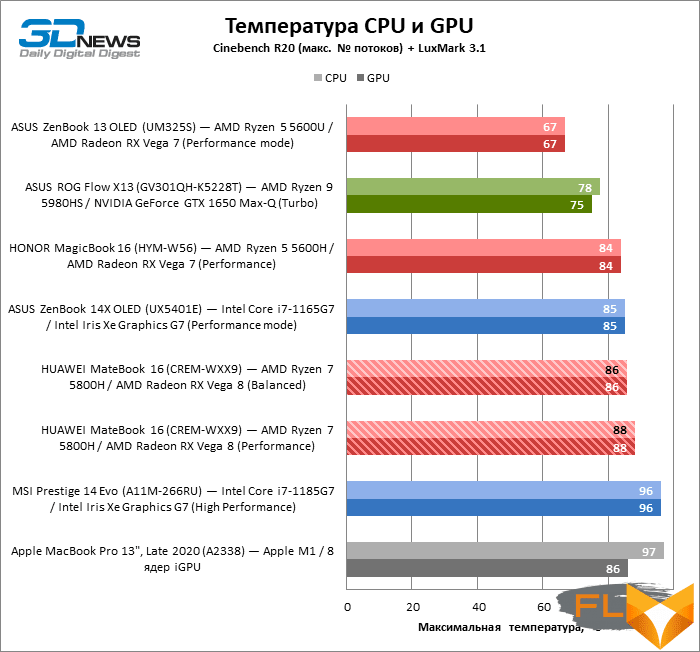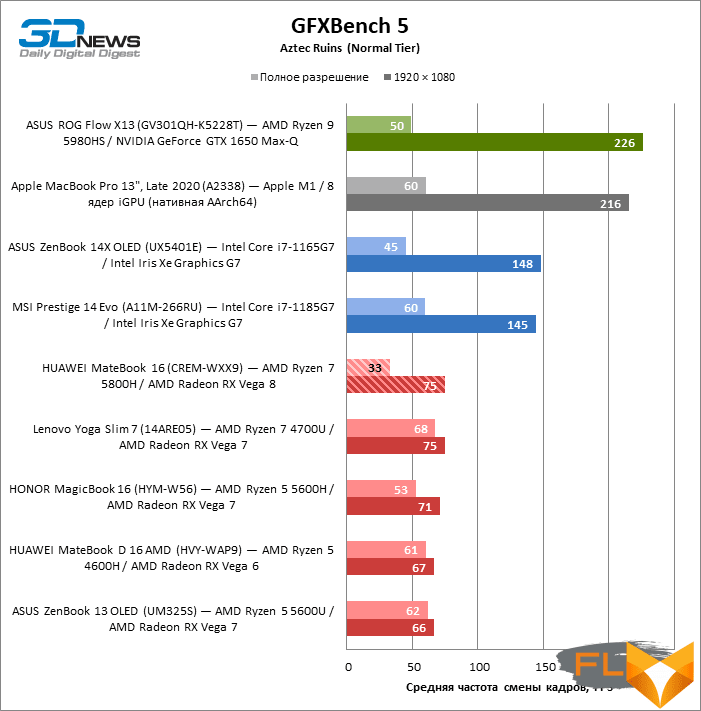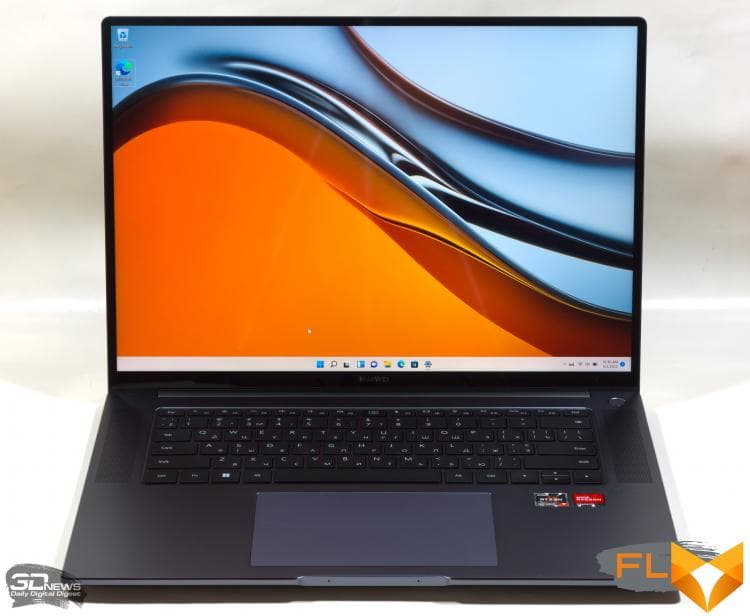


In reviews of work laptops, we no longer paid attention to the fact that mobile computers with a screen diagonal of 13 inches are already largely bypassing the market with 14-inch models, and now 16-inch screens are claiming to replace the usual size of 15.4. While the big ultrabooks and all-in-one laptops are yet to reach a turning point, some manufacturers have already taken the next step by moving away from the 16:9 aspect ratio in what we consider to be a significant 3:2 aspect ratio. HUAWEI MateBook 16 is just one of these, so far few, products.

⇡#Price specifications,
As usual at HUAWEI, laptop detection does not allow entry into the list of main components, however, the MateBook 16 has a large part of the buyers, for exclusively avid gamers and professional software users who actively use the GPU – because there is no discrete GPU in this machine. But the performance of the central processor is in abundance. HUAWEI chose the top eight-core processor of the Ryzen 5000 family with the H index – the maximum power consumption of up to 54 W and clock speeds. Higher in the hierarchy of Cezanne chips are only Ryzen 9 models, which are even rarer in ultrabooks.
Together with the eight Zen 3 cores released by the mobile processors, AMD has installed the versatile Radeon RX Vega graphics with a maximum number of shader ALUs of 512, while six six-core processors are supplied with 448 units. Of course, even the best integrated graphics processor such as the GCN architecture is not a replacement for discrete video adapters and is still inferior to the Intel Xe graphics in the 3D rendering standard, but the Radeon RX Vega 8 makes a good impression in some promising tasks.
The amount of RAM MateBook 16 is 16 GB. HUAWEI uses DDR4 chips, which outperform the LPDDR4(X) common in compact laptops in terms of overall bandwidth, and, of course, the RAM here works in dual-channel mode (despite the fact that single-channel RAM is again a rarity for modern ultrabooks).
| Manufacturer | HUAWEI |
|---|---|
| Model | MateBook 16 (CREM-WXX9) |
| Display | 16”, 2520 × 1680, IPS |
| CPU | AMD Ryzen 7 5800H (8/16 cores/threads, 3.2-4.4GHz) |
| RAM | DDR4 SDRAM, 3200 MT/s, 16 GB (two channels) |
| GPU | AMD Radeon RX Vega 8 (512 MB from system memory) |
| Accumulator | WD PC SN730 (PCIe 3.0 x4) 512GB |
| External I/O connectors | 2 × USB 3.2 Gen 1 Type-A;2 × USB 3.2 Gen 1 Type-C;
1 × HDMI; 1 × TRS 3.5mm |
| Network | IEEE 802.11ac;Bluetooth 5.0 |
| Battery capacity, Wh | 84 |
| Weight, kg | 1.99 |
| Overall dimensions (L × W × H), mm | 351 × 254.9 × 17.8 |
| Retail price $ | 1600 |
The weak point in the configuration of the HUAWEI laptop is the communication capabilities. Forgive the lack of Thunderbolt controllers, because this interface was not available “red” until the advent of the USB4 standard, which guarantees backward compatibility with the third version of TB and is supported by the latest Ryzen 6000 series processors. However, all USB ports on board the MateBook 16 work in 3.2 Gen 1 mode instead of the faster USB 3.2 Gen 2. The Wi-Fi module, in turn, is limited to the IEEE 802.11ac protocol and does not support Wi-Fi 6. However, not so much many users need such high bandwidth wired and wireless connections that it becomes a reason to abandon the HUAWEI MateBook 16.
As for the price of the device, it costs $1,600 in the manufacturer’s official online store, which, I must say, is quite inexpensive by the standards of ultrabooks with powerful stuffing. Moreover, the MateBook 16 has special “chips” that more expensive offers from famous brands cannot boast of.
⇡#Look and Ergonomics
The main thing that captivates the MateBook 16 is, of course, a huge screen – 16 inches diagonally. The large panel size itself is no longer something out of the ordinary for thin laptops, which is not the case with the 3:2 aspect ratio. Few laptop manufacturers other than HUAWEI prefer this format. It’s a pity, because it is he who is best suited to mobile computers for several reasons at once. Firstly, it simply provides a larger area with an equal diagonal compared to common 16:9 matrices. Secondly, the user interface of the OS and applications is still designed in such a way that vertical space is more in demand than horizontal. Finally, the tall screen allows for smaller bezels at the top and bottom without compromising the touchpad area. In MateBook 16, they are extremely thin at all due to the fact that the webcam was placed in a row of function keys under the pressure cover – we have already seen this solution in the HUAWEI laptop released earlier (MateBook 14 2021).
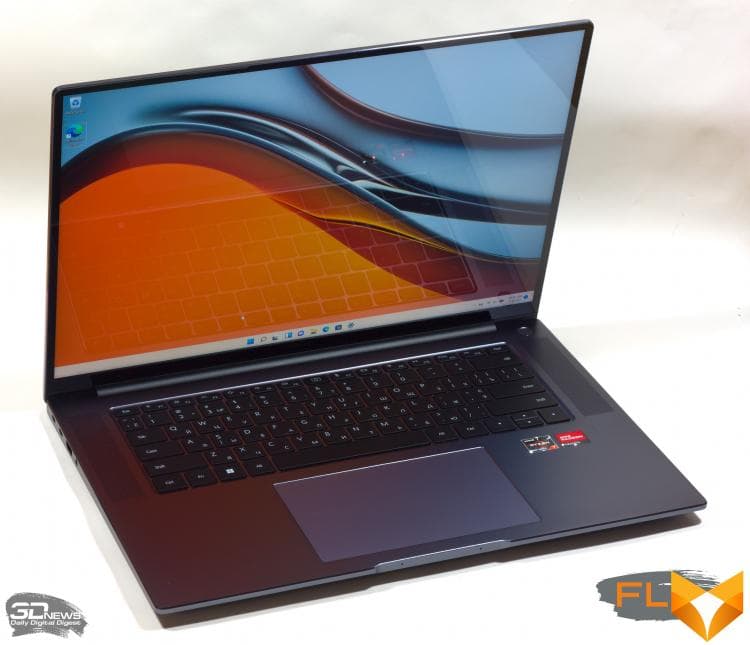
A resolution of 2520 × 1680 is unimaginative at 16 inches, but provides a satisfying pixel density. The only thing we can complain about is the low quality of the anti-reflective coating: in bright light, the screen turns into a mirror, which, however, partly compensates for a good margin of brightness.
The case of the MateBook 16 is assembled from aluminum panels and, despite its large dimensions, it turned out to be quite rigid. Thanks to the glass on top of the screen, the cover is difficult to bend with a screw, and the keyboard panel is almost not deformed during the printing process. The laptop opens with one hand and allows you to tilt the lid, if not all 180 °, but still at a significant angle. Due to the size, powerful cooling system befitting an eight-core Ryzen category H processor, and a glazed screen, HUAWEI turned out to be a rather weighty laptop – even without the power supply, the machine pulls almost 2 kg.
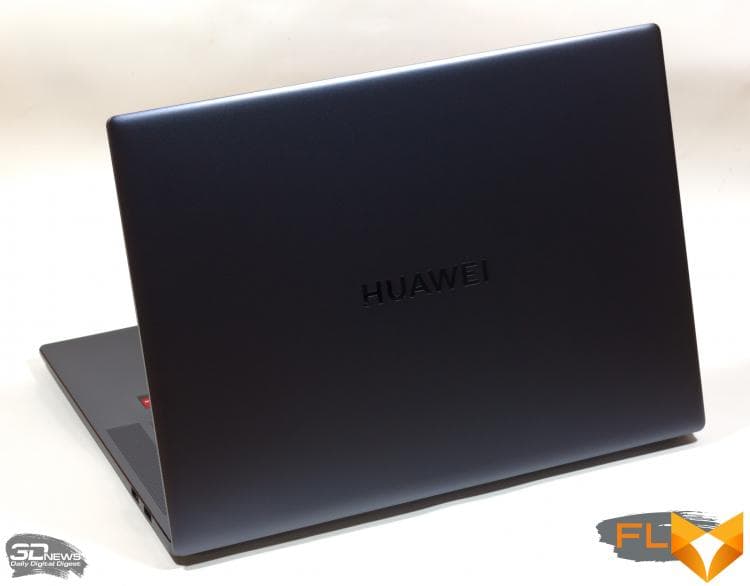
The mechanical qualities of the MateBook 16 keyboard are not ashamed to compare with significantly more expensive devices than a laptop owes much to the hard base of the work surface. However, by a fairly loud sound during printing, it is noticeable that there is still a lot of free space inside the case, and the moment of operation of the mechanisms could be clearer. But the keyboard is devoid of another drawback inherent in many modern laptops – the “viscous” cones of the membrane, which slowly return the key covers to a neutral position. The keyboard has a white two-stage backlight – alas, quite dim even at maximum brightness.
The touchpad is large, glassy and well fixed in the case, which means that it does not make any extraneous sounds when pressed lightly. The panel setting provides perfect tracking, we did not notice any cursor breaks during testing.
A fingerprint scanner integrated into the power button is gradually becoming the norm for Windows laptops, and the HUAWEI MateBook 16 is another example of this.
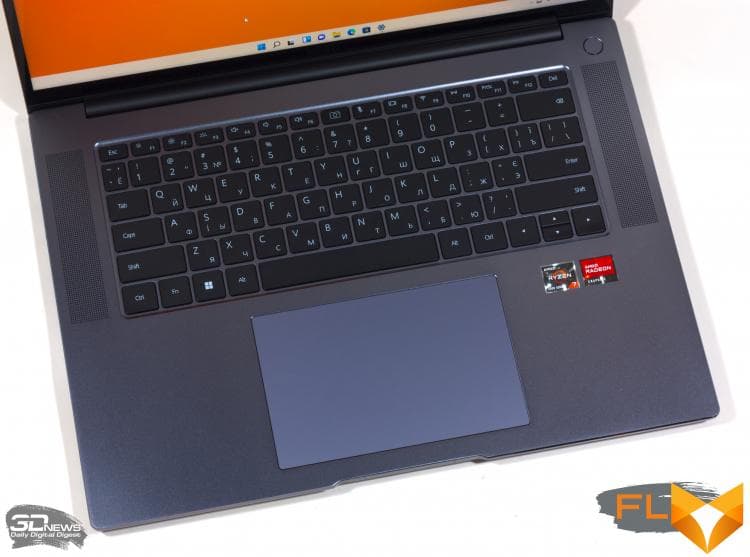
The laptop has a sufficient set of connectors for connecting peripherals: two USB Type-C ports on one side, two Type-A on the other, full-size HDMI and an acoustic mini-jack. The only pity is that the USB connectors here are not the fastest, and one of them claims the cable from the power supply.

The MateBook 16 is powered by a nice custom 75W PSU.
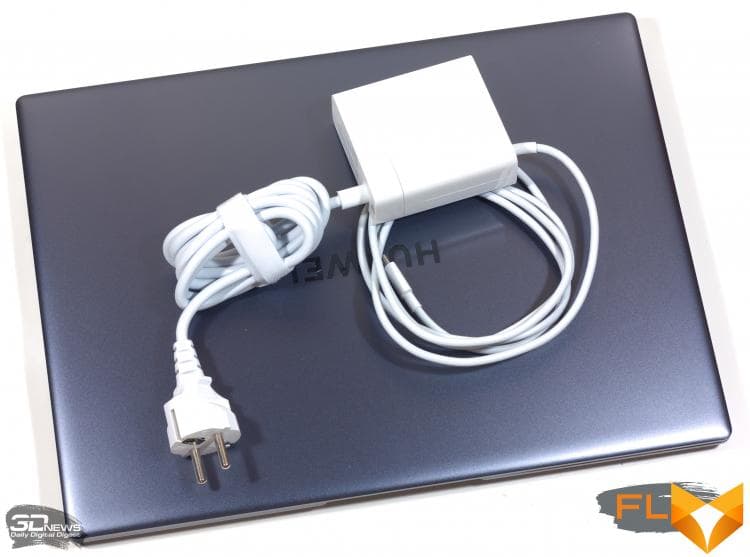
⇡#Internal design and upgrade options
The MateBook 16 cooling system works according to a typical pattern, when cold air enters the case through holes in the bottom, and heated air is thrown out between the work surface and the screen.
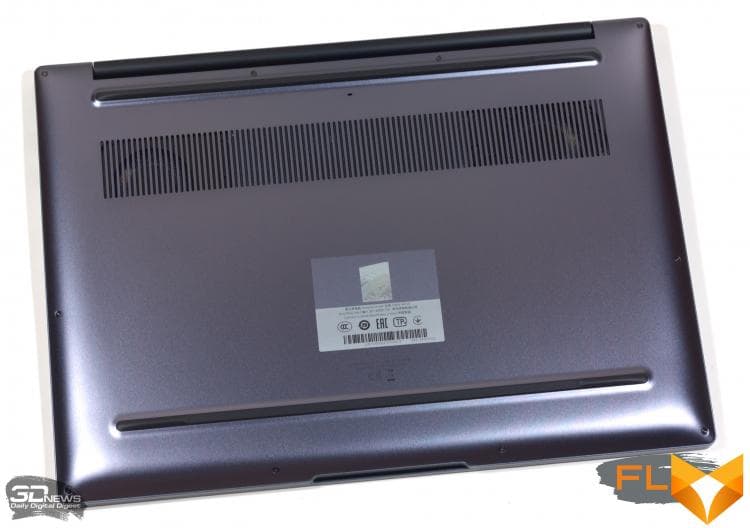
The cooler consists of two heat pipes that form a bridge between the CPU heat sink and two heatsinks. And by the way, please note that the motherboard has a wiring for a discrete graphics processor, although the manufacturer, unfortunately, does not offer such a configuration for the MateBook 16.
The only user-replaceable component of the laptop is the solid state drive, hidden under a metal cover. RAM, on the contrary, is soldered on the motherboard, although the DDR4 type, unlike LPDDR4 (X), exists in the form of SO-DIMM modules. But the MateBook 16 has a large 84 Wh battery, and all external connectors are reinforced with metal brackets.
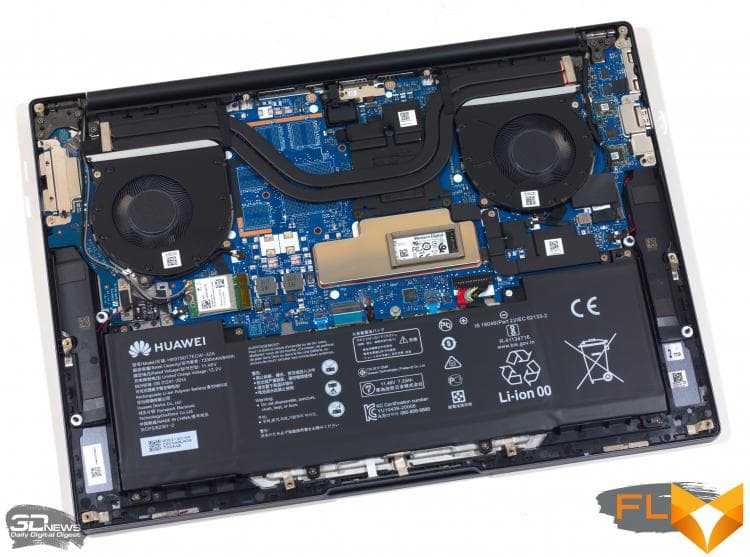
⇡#Test Methodology
| Synthetic tests | |
|---|---|
| Application | Settings |
| 3DMark Time Spy | — |
| Geekbench 5 | — |
| CINEBENCH R23 | — |
| GFXBench 5 (Aztec Ruins — Normal Tier, High Tier) | Windows: Vulkan, macOS: Metal |
| fio 3.16 | Sequential read/write, random read/write (unbuffered I/O) |
| Working Applications | |||||
|---|---|---|---|---|---|
| Application | Benchmark | Settings/Notes | API | ||
| Intel Graphics | AMD Graphics | NVIDIA Graphics | |||
| Adobe Photoshop 2021 (22.x) | PugetBench for Photoshop 0.93 (list of tests at the link) | — | OpenGL + OpenCL + Metal (macOS) | OpenGL + OpenCL + Metal (macOS) | OpenGL + OpenCL |
| Adobe Photoshop Lightroom Classic 10.x | PugetBench for Lightroom Classic 0.92 (list of tests here) | — | DirectX 12 (Windows) | DirectX 12 (Windows) | DirectX 12 |
| Adobe Premiere Pro 2021 (15.x) | PugetBench for Premiere Pro V0.95.1 (list of tests here) | Standard Benchmark (4K) | OpenCL (Windows)/Metal (macOS) | OpenCL (Windows)/Metal (macOS) | CUDA |
| Blender 2.9x | Class Room demo from Blender Foundation | Cycles renderer.Feature Set: Supported.
Tile size: 32 × 32 (CPU) or 256 × 256 (GPU) |
N/A (CPU rendering) | OpenCL (Windows)/CPU (macOS) | CUDA/OptX |
Display testing is performed using the X-Rite i1Display Pro Plus colorimeter in the DisplayCAL 3 application.
Notebook battery life is measured at a display brightness of 200 cd/m2 in the following usage scenarios:
- web surfing: alternately opening and closing tabs of sites, Computeruniverse.ru and Unsplash.com with an interval of 25 seconds in the Google Chrome browser (cache and cookies are disabled);
- Continuous playback of 4K HEVC (H.265) video.
⇡#Test participants
The following devices took part in testing:
| Screen | CPU | RAM | GPU | SSD | HDD | Battery< /th> | |||
|---|---|---|---|---|---|---|---|---|---|
| HUAWEI MateBook 16 (CREM-WXX9) | 16”, 2520 × 1680, IPS | AMD Ryzen 7 5800H | 8/16 cores/threads, 3.2-4.4GHz | DDR4 SDRAM, 3200 MT/s, 16 GB | AMD Radeon RX Vega 8 | 512MB of system RAM | WD PC SN730 (PCIe 3.0 x4) 512GB | None | 84 Wh |
| Apple MacBook Pro 13″, Late 2020 (A2338) | 13.3”, 2560 × 1600, IPS | Apple M1 | 4+4 cores/threads, ≤3.2GHz | LPDDR4X SDRAM, 4266 MT/s, 16 GB | 8 iGPU cores | System RAM | Apple AP2048Q (Apple Fabric) 2048 GB | None | 58.2 Wh |
| ASUS ROG Flow X13 (GV301QH-K5228T) | 13.4”, 3840 × 2400, IPS | AMD Ryzen 9 5980HS | 8/16 cores/threads, 3.1-4.8GHz | LPDDR4X SDRAM, 4266 MT/s, 32 GB | NVIDIA GeForce GTX 1650 Max-Q | 4GB GDDR6 | WD PC SN530 (PCIe 3.0 x4) 1024 GB | None | 62 Wh |
| ASUS ZenBook 13 OLED (UM325S) | 13.3”, 1920 × 1080, OLED | AMD Ryzen 5 5600U | 6/12 cores/threads, 2.3-4.2GHz | LPDDR4X SDRAM, 4266 MT/s, 16 GB | AMD Radeon RX Vega 7 | 512MB of system RAM | SK Hynix PC711 (PCIe 3.0 x4) 512 GB | None | 67 Wh |
| ASUS ZenBook 14X OLED (UX5401E) | 14”, 2880 × 1800, OLED | Intel Core i7-1165G7 | 4/8 cores/threads, 2.8-4.7GHz | LPDDR4X SDRAM, 4266 MT/s, 16 GB | Intel Iris Xe Graphics G7 | 1 GB from system memory | Samsung PM9A1 (PCIe 4.0 x4) 1024 GB | None | 63 Wh |
| HONOR MagicBook 16 (HYM-W56) | 16.1”, 1920 ×1080, IPS | AMD Ryzen 5 5600H | 6/12 cores/threads, 3.3-4.2GHz | DDR4 SDRAM, 3200 MT/s, 16 GB | AMD Radeon RX Vega 7 | 512MB of system RAM | Samsung PM9A1 (PCIe 3.0 x4) 512 GB | None | 56 Wh |
| HUAWEI MateBook D 16 AMD (HVY-WAP9) | 16.1”, 1920 × 1080, IPS | AMD Ryzen 5 4600H | 6/12 cores/threads, 3.0-4.0GHz | DDR4 SDRAM, 3200 MT/s, 16 GB | AMD Radeon RX Vega 6 | 512MB of system RAM | WD PC SN730 (PCIe 3.0 x4) 512GB | None | 56 Wh |
| Lenovo Yoga Slim 7 (14ARE05) | 14”, 1920 × 1080, IPS | AMD Ryzen 7 4700U | 8/8 cores/threads, 2.0-4.1GHz | LPDDR4X SDRAM, 4266 MT/s, 16 GB | AMD Radeon RX Vega 7 | 512MB of system RAM | UMIS RPITJ256VME2MWD (PCIe 3.0 x4) 256 GB | None | 61 Wh |
| MSI Prestige 14 Evo (A11M-266RU) | 14″, 1920 × 1080, IPS | Intel Core i7-1185G7 | 4/8 cores/threads, 3.0-4.8GHz | LPDDR4X SDRAM, 4266 MT/s, 16 GB | Intel Iris Xe Graphics G7 | 1 GB from system memory | Phison 1TB SM2801T24GKBB4S-E162 (PCIe 4.0 x4) 1024 GB | None | 52 Wh |
⇡#Screen Quality
A screen with 3:2 aspect ratio and a fairly high pixel density is the pride of HUAWEI MateBook 16. However, its advantages are not limited to these parameters. The matrix has a good margin of brightness – 324 cd/m2 and an unconditionally high contrast ratio – 1606:1.
The color range of the screen almost completely covers the sRGB space.
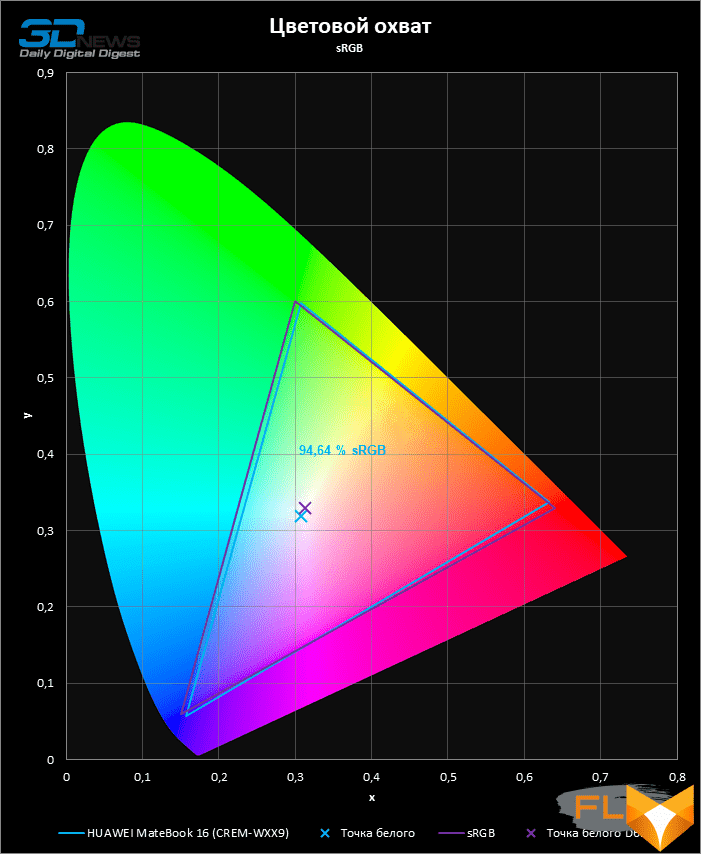
The color temperature is higher than the standard 6500K, but is stable throughout most of the gray scale.
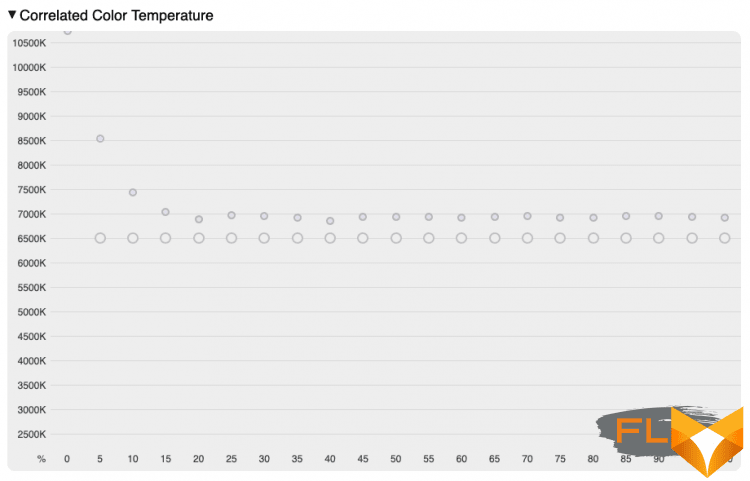
Gray balance is accurate and uniform in medium to high brightness areas of the image. The gamma correction curve deviates from the sRGB standard, but in favor of an increased contrast of dark tones, which is acceptable with such a high “physical” contrast of the matrix.
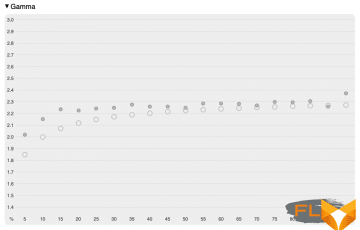 |
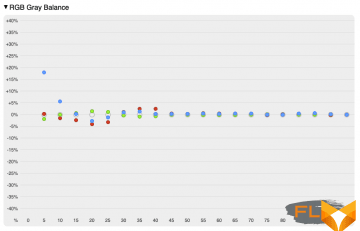 |
As a consequence of the good gray balance, the screen of the HUAWEI MateBook 16 earned high marks for Delta E color accuracy adjusted for native white point.
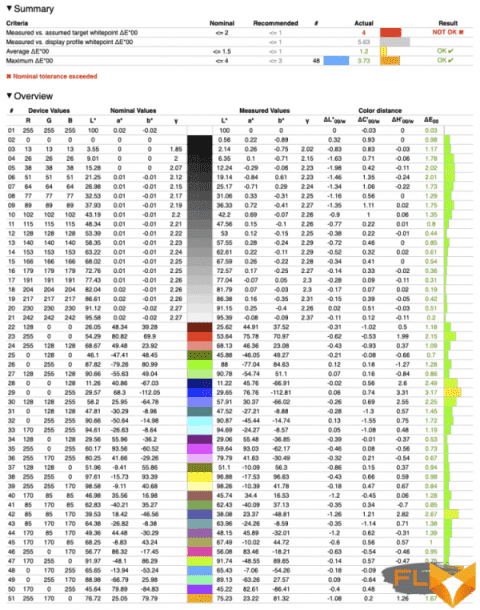
⇡#Clock speeds, temperature and noise level
The HUAWEI MateBook 16 control software gives you the choice between two CPU power modes – “balanced” and “performance”. As we expected, in the “productive” mode, the CPU develops the full power required by the Ryzen 7 5800H chip according to AMD specifications – 54 W – and, as a result, maintains high clock speeds – about 3.5 GHz with intensive multi-threaded load. The integrated Radeon RX Vega 8 GPU is also clocked higher than the 6-core Ryzen GPU clocked at 2GHz. And even in a situation where both x86 cores and GPU are loaded at the same time, both components do not slow down too much: the CPU frequency is kept at 3.2 GHz, and the graphics at 1.9 GHz.
| Load clocks | ||||||||
|---|---|---|---|---|---|---|---|---|
| Cinebench R20 (max thread no) | Blender 2.9x (GPU rendering) | Cinebench R20 (max thread no.) + Blender 2.9x | ||||||
| CPU clock speed, MHz | GPU clock speed, MHz | CPU clock speed, MHz | GPU clock speed, MHz | |||||
| Medium | Max | Medium | Max | Medium | Max | Medium | Max | |
| HUAWEI MateBook 16 (CREM-WXX9) – AMD Ryzen 7 5800H / AMD Radeon RX Vega 8 – Performance | 3535 | 3569 | 2000 | 2000 | 3242 | 3294 | 1900 | 2000 |
| HUAWEI MateBook 16 (CREM-WXX9) – AMD Ryzen 7 5800H / AMD Radeon RX Vega 8 – Balanced | 3362 | 3394 | 2000 | 2000 | 3202 | 3369 | 1241 | 2000 |
| CPU and GPU power consumption | ||||||||
|---|---|---|---|---|---|---|---|---|
| Cinebench R20 (max thread no) | Blender 2.9x (GPU rendering) | Cinebench R20 (max thread no.) + Blender 2.9x | ||||||
| CPU power consumption, W | GPU power consumption (SoC as a whole, if integrated), W | CPU power consumption, W | GPU power consumption (if discrete), W | |||||
| Medium | Max | Medium | Max | Medium | Max | Medium | Max | |
| HUAWEI MateBook 16 (CREM-WXX9) – AMD Ryzen 7 5800H / AMD Radeon RX Vega 8 – Performance | 54 | 56 | 14 | 18 | 54 | 55 | N/A | N/A |
| HUAWEI MateBook 16 (CREM-WXX9) – AMD Ryzen 7 5800H / AMD Radeon RX Vega 8 – Balanced | 45 | 45 | 14 | 22 | 45 | 45 | N/A | N/A |
Note The measurement is performed after the device has warmed up and all parameters have stabilized.
Of course, the Cezanne crystal, in which the lion’s share of the power falls on the x86 cores, heats up to 96 ° C in multi-threaded tasks, and the cooling system is quite noisy. However, the MateBook 16 cooler is far from the loudest among those that we came across in mobile computers. And most importantly, a HUAWEI laptop can be made much quieter at the cost of a small loss in performance by switching the SoC to balanced mode. This setting lowers the sustained multi-threaded x86 core clock speed to 3.35 GHz, while both components hover around 3.2 GHz and 1.25 GHz respectively when running the GPU at the same time. GPU clock speeds in tasks that cause minimal CPU load are not affected by power mode.

⇡#Synthetic performance tests
As you might expect, the Ryzen 5000-series octa-core processor, endowed with plenty of headroom, dominates most competitors in synthetic benchmarks that do not have the same number of x86 cores or similarly high clock speeds. The clock speeds of the Ryzen 7 5800H cancel out the advantage of 11th generation Intel chips in single-threaded performance, and in multi-threaded mode, only the even more powerful Ryzen 9 5980H and, based on Geekbench data, the Apple M1 managed to demonstrate the best result when running native ARM code.
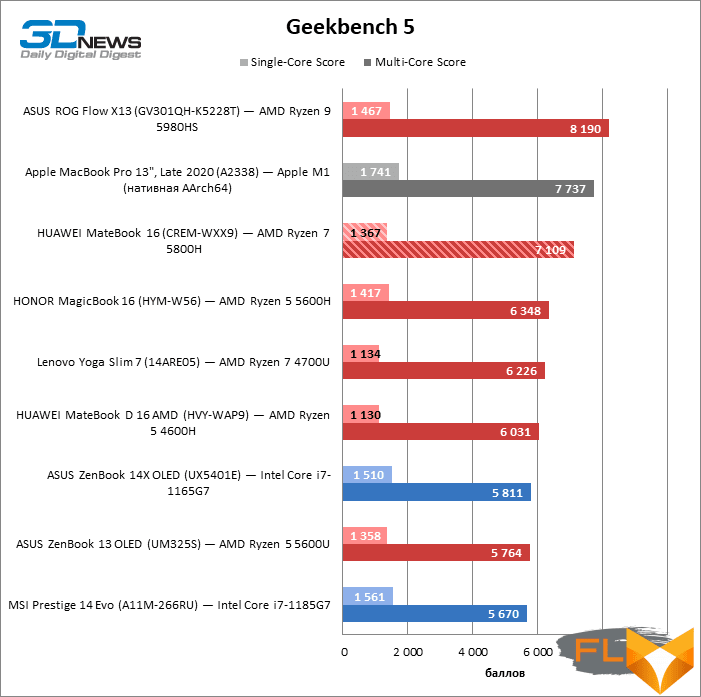
As for integrated graphics, the benchmarks reacted to the difference in the number of shader ALUs between the Radeon RX Vega 8 and lower-performance varieties of the same video core (Vega 7 and Vega 6) used in AMD’s six-core chips. However, the speed boost is still not enough to compete with Intel’s 12th generation (Xe) graphics, and even more so with the integrated Apple M1 GPU. The HUAWEI MateBook 16 is not a gaming laptop, but even a number of work applications can hardly do without a discrete GPU.
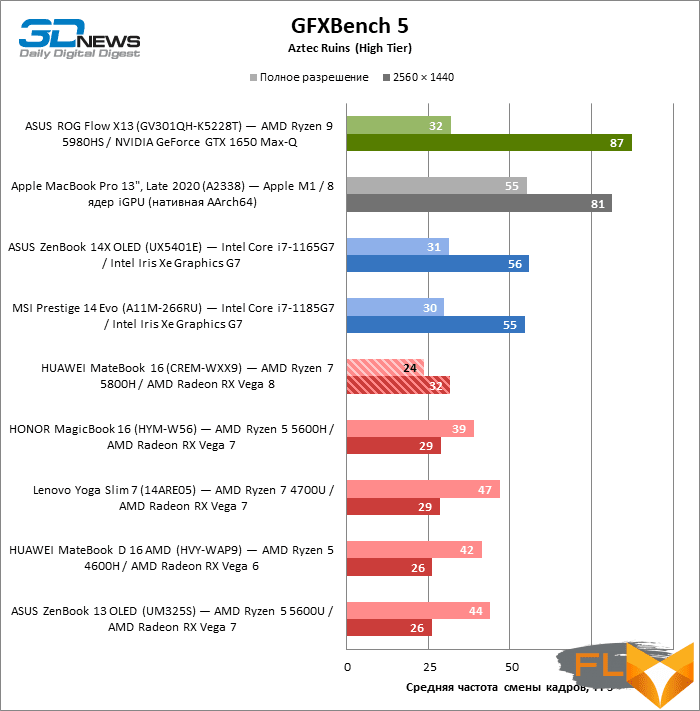
⇡#Performance in production applications
The HUAWEI MateBook 16 took the lead in the Blender benchmark for CPU rendering and outperforms even a Ryzen 9 5980H based laptop (ASUS ROG Flow X13). This is because the HUAWEI machine is equipped with DDR4 system memory, while the ROG Flow X13 uses the slower LPDDR4X type. Laptops with economical versions of the Ryzen U-series, Apple M1, and even more so low-wattage Intel CPUs can do nothing to oppose the brute force of the MateBook 16.

The integrated graphics processor Radeon RX Vega 8, like any GPU of the formally outdated GCN architecture, performs better in computational tasks than in 3D rendering. And now it turned out to be much faster than the related Vega 7 video core when rendering in Blender and, by and large, works no worse than the Intel Xe Graphics G7. However, when the user has such a powerful central processor at his disposal, it makes no sense to shift such a load to the integrated graphics – the project export time only increases from this.
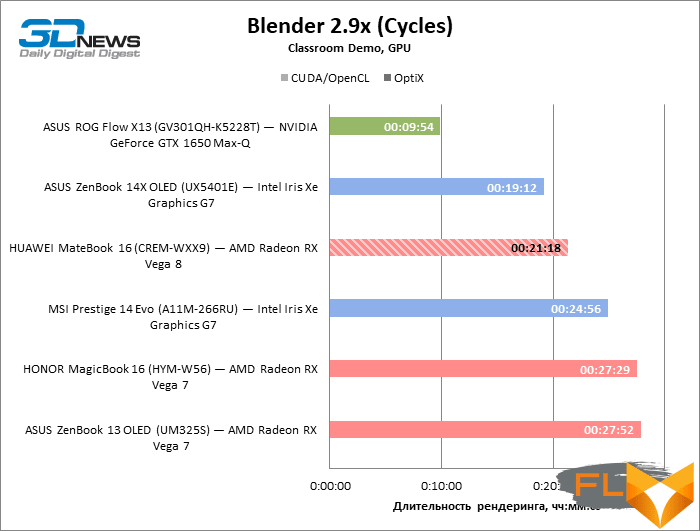
Lightroom is traditionally not the most favorable working environment for AMD processors, but eight cores running at high clock speeds allowed the MateBook 16 to reach the level of laptops equipped with low-wattage Intel chips. And, apparently, only the relatively slow SSD stole the gold medal from the HUAWEI laptop in this benchmark.
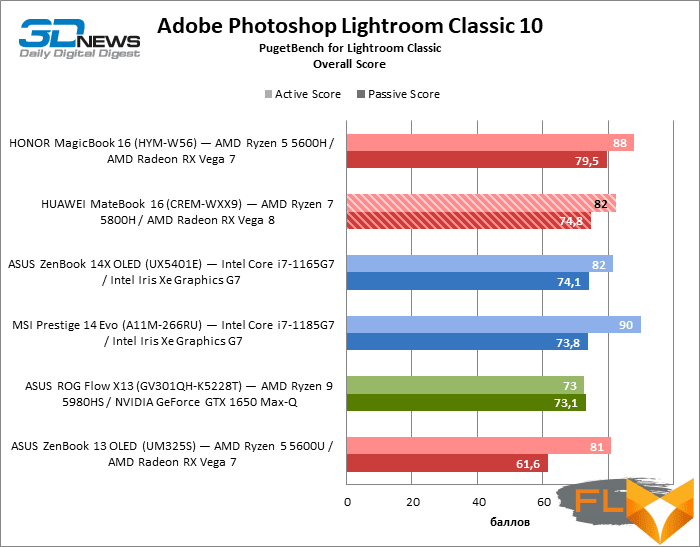
Note Scores are calculated as a percentage of Intel Reference Workstation performance Core i9-9900K, NVIDIA GeForce RTX 2080, 64GB RAM.
Like Lightroom, “big” Photoshop doesn’t require high performance from the GPU, so the HUAWEI laptop came close to the leading device based on the Ryzen 9 5980H and GeForce GTX 1650 Max-Q in the aggregate score of the PugetBench test suite. On the other hand, eight x86 cores gave the MateBook 16 not much when you look at the results of a machine with a six-core Ryzen H-series. But the performance of energy-efficient chips from Intel and Apple M1, which was forced to pass the test in x86 emulation mode (due to the fact that there is no benchmark for the new, native version of Photoshop yet), is already noticeably lower compared to MateBook 16.
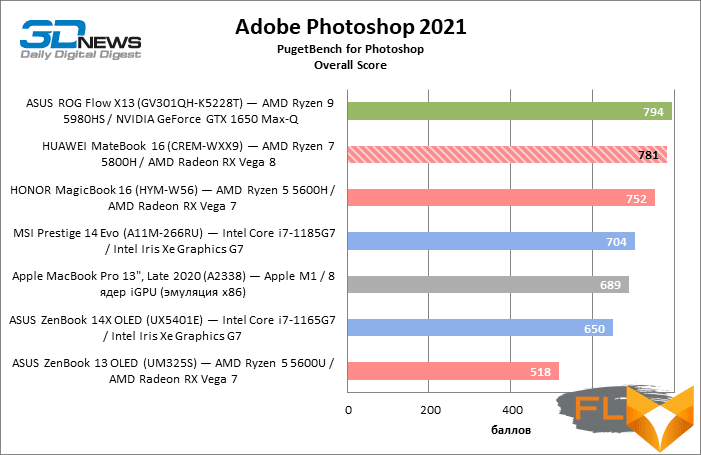
Note Scores are calculated as a percentage of Intel Reference Workstation performance Core i9-9900K, NVIDIA GeForce RTX 2080 and 64GB RAM x 10.
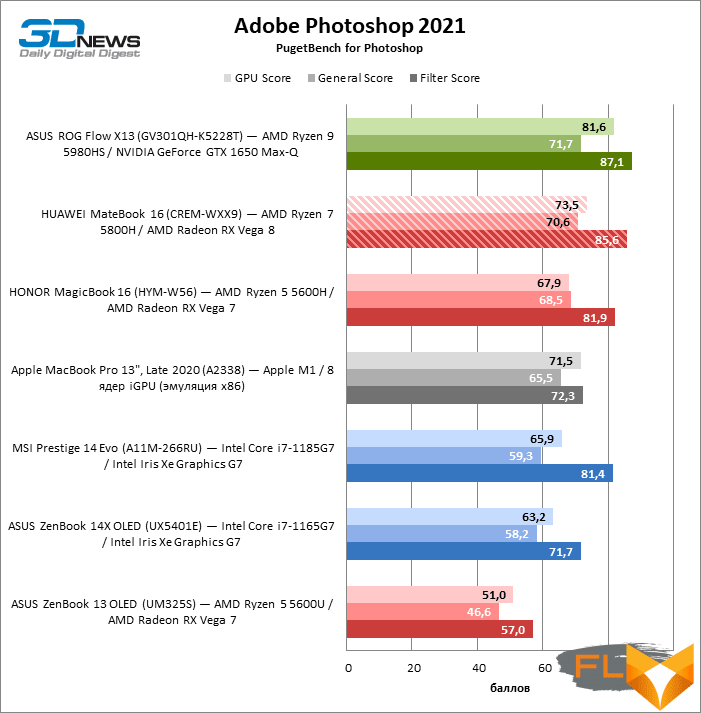
Note Scores are calculated as a percentage of Intel Reference Workstation performance Core i9-9900K, NVIDIA GeForce RTX 2080, 64GB RAM.
Video editing 4K video is a task that can no longer be done without a high-performance GPU. As a result, this test is dominated by the Apple M1 chips (assuming the ARM-compiled version of Premiere Pro is used) and the eight-core Ryzen combined with the GeForce GTX 1650 Max-Q. And the MateBook 16, on the other hand, is only marginally better than a similar computer with a six-core “red” H-series processor in the overall assessment.
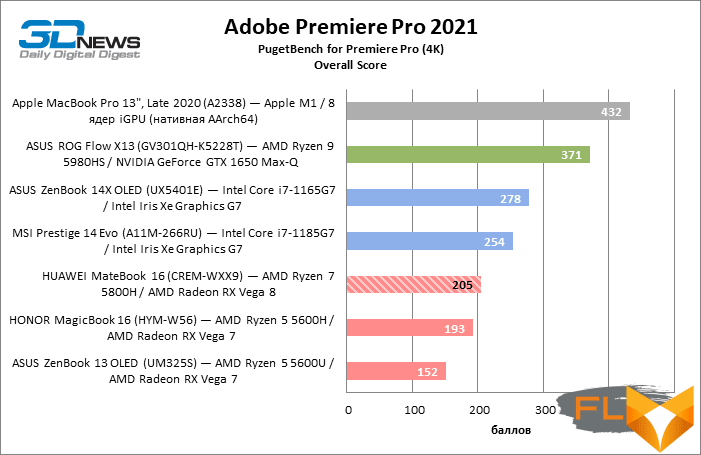
Note Scores are calculated as a percentage of AMD reference workstation performance Ryzen 9 5900X, NVIDIA GeForce RTX 3080 and 64GB RAM x 10.
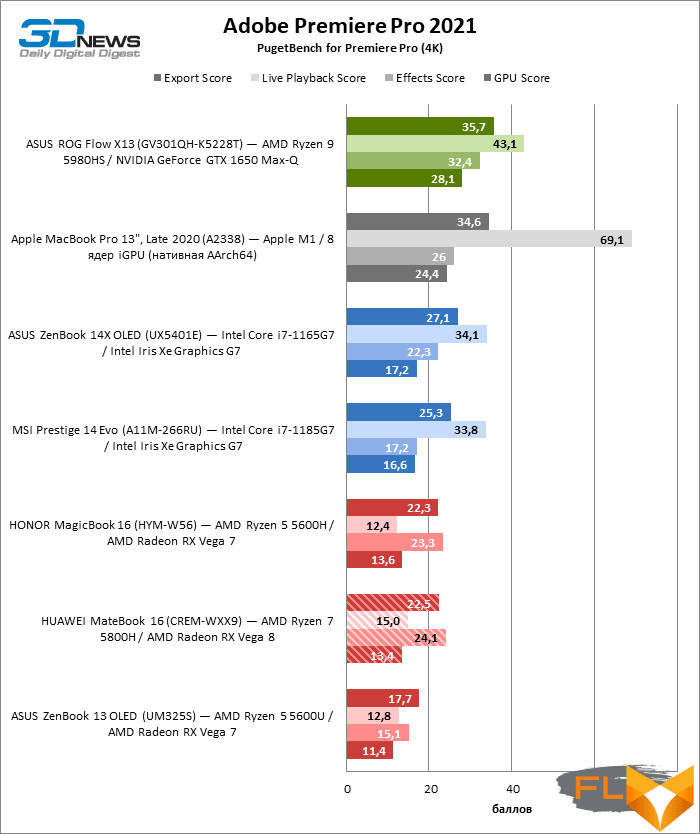
Note Scores are calculated as a percentage of AMD reference workstation performance Ryzen 9 5900X, NVIDIA GeForce RTX 3080, 64GB RAM.
The most annoying thing is that even without a discrete GPU, low-wattage Intel processors develop higher frame rates in Premiere Pro, especially in MultiCam mode. Well, sufficiently powerful graphics allow you to count on a frame rate of under 60 FPS. However, if the user does not need MultiCam or complex effects, and the original video was shot at a frame rate of 30 FPS, then the MateBook 16 will not have any problems with it. But the export of the project, again, the “red” chips without the help of a discrete GPU are equally slow – unlike the “blue” competitors and the Apple M1.
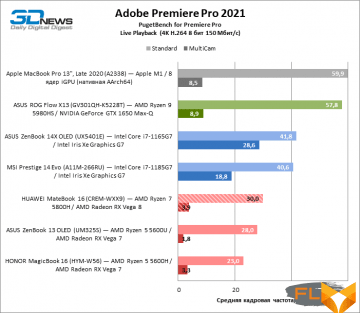 |
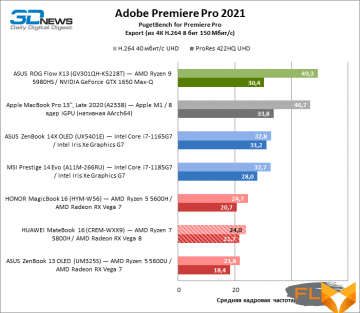 |
⇡# SSD Performance
As a ROM for the MateBook 16, the manufacturer chose a relatively inexpensive WD PC SN730 solid-state drive, which has a very uneven performance profile in four main metrics. In terms of linear write speed, the PC SN730 is by and large not inferior to other common SSDs with PCI Express 3.0 interface, but only with a long queue of commands. In linear recording mode, this is already a frankly slow drive. Its random write speed is also quite mediocre. But in terms of random read speed, the PC SN730 can compete with the best solutions that are most often used by laptop manufacturers – of course, subject to the high performance of the CPU required to process such a number of requests to the drive.
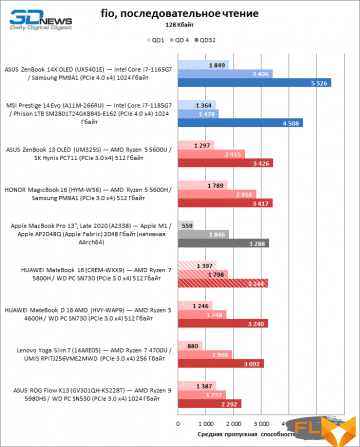 |
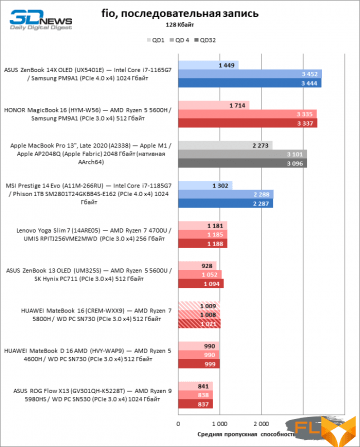 |
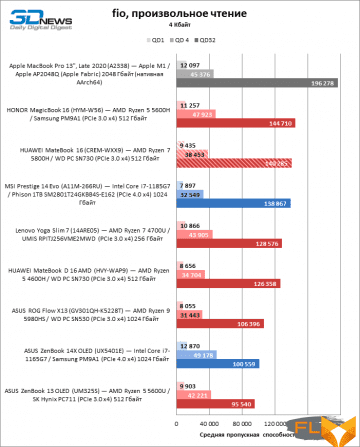 |
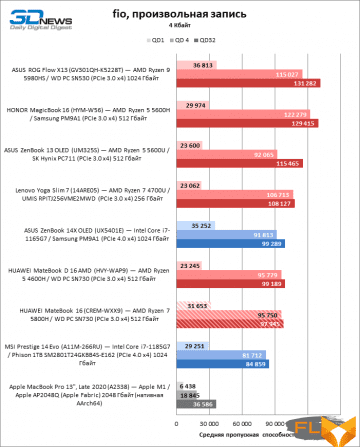 |
⇡# Battery life
The high capacity of the HUAWEI MateBook 16 battery (84 Wh) was not in vain. In balanced power mode with the screen brightness lowered to 200 cd/m2, the laptop lasted over eight hours of video playback and almost 11 hours of continuous web surfing.
⇡#Conclusions
HUAWEI once again has an interesting machine at an affordable price, which in many ways will give a light to the more expensive products of well-known brands in the laptop market. It’s enough that it’s one of those still rare devices with a comfortable 3:2 screen aspect ratio, and those who use the webcam only for their annual family call will appreciate the thin bezels on all sides of the panel. Moreover, it is also a very high-quality screen with a good margin of brightness, high contrast and color accuracy (only the anti-glare coating let us down). The MateBook 16 also has no complaints about the key mechanics, boasts a huge, well-tuned touchpad, and lasts a long time away from the outlet thanks to a capacious battery.
In principle, the listed advantages are already an exhaustive recommendation for any ultrabook, but with a screen diagonal of 16 inches, a mobile computer can already afford a CPU that is more productive than common low-wattage Intel or AMD chips, and here is a whole eight-core Ryzen with a 54-watt thermal package. As a result, when it comes to performance tasks that require nothing more than a powerful CPU, the MateBook 16 ranks in the top echelon of mobile computing alongside thick gaming laptops and workstations. The range of its capabilities narrows only the lack of a discrete graphics processor.
The manufacturer had to make other sacrifices to keep the attractive price of the MateBook 16. Unfortunately, there is no laptop version with 1TB of ROM, and the RAM is soldered to the motherboard. Finally, USB ports are limited to 3.2 Gen 1 speed mode. But for buyers who choose a large-screen Ultrabook and are willing to forgive these costs, HUAWEI, whatever one may say, has made a very tempting offer.
FAQ HUAWEI MateBook 16 (CREM-WXX9)
What processor does the MateBook 16 R7 5800H use?
The MateBook 16 R7 5800H is equipped with an AMD Ryzen 7 5800H processor.
How does the MateBook 16s differ from the new Huawei MateBook 16?
The MateBook 16s typically features updated specifications or design improvements compared to the new Huawei MateBook 16.
Can I contact Huawei for support regarding my MateBook 16 CREM-WFD9?
Yes, you can contact Huawei for support regarding your MateBook 16 CREM-WFD9 through their “Contact Us” page.
What is the battery capacity of the Huawei MateBook 16 CREM-WFD9?
The Huawei MateBook 16 CREM-WFD9 laptop typically comes with a battery capacity of 84Wh.
Yes, Huawei Share is available on the Huawei MateBook 16 laptop, allowing seamless connectivity with other Huawei devices.
What is the RAM and storage specification of the MateBook 14s?
The MateBook 14s commonly comes with 16GB of RAM and a 512GB SSD for storage.
How can I buy the Huawei MateBook 16 in Singapore?
You can buy the Huawei MateBook 16 in Singapore through Huawei’s official website, local electronics retailers, or authorized online stores.
What type of USB port is available on the Huawei MateBook 16 CREM-WXX9 laptop?
The Huawei MateBook 16 CREM-WXX9 laptop includes a USB-C port.
Does the MateBook 16 CREM-WFD9 laptop support an upgrade to Windows 11?
Yes, the MateBook 16 CREM-WFD9 laptop supports an upgrade to Windows 11.
What is the core and thread count of the 5800H processor in the MateBook 16?
The 5800H processor in the MateBook 16 has 8 cores and 16 threads.
What type of battery is used in the Huawei MateBook 16 CREM-WFD9?
The Huawei MateBook 16 CREM-WFD9 uses a Li-ion battery.
Can I purchase a genuine Huawei MateBook 16 at a lower price?
Yes, you can find genuine Huawei MateBook 16 laptops at a lower price during sales or from authorized retailers offering discounts.
Where can I buy a Huawei MateBook 16 in Singapore?
You can buy the Huawei MateBook 16 in Singapore through official Huawei stores, authorized electronics retailers, or online marketplaces.
Is there a laptop battery replacement available for the MateBook 16 CREM-WFD9?
Yes, laptop battery replacements are available for the MateBook 16 CREM-WFD9.
What are the features of the new MateBook 16?
The new MateBook 16 is equipped with an SSD for storage, long battery life, and may include a dedicated GPU depending on the model.
Does the MateBook 16 CREM-WXX9 come with a dedicated GPU?
Some configurations of the MateBook 16 CREM-WXX9 come with a dedicated GPU, while others might lack one.
How many cells does the battery of the Huawei MateBook 16 have?
The battery of the Huawei MateBook 16 typically has 6 cells with a capacity of 84Wh.
What is the part number for the Huawei MateBook 16 CREM-WFD9 laptop battery?
The part number for the Huawei MateBook 16 CREM-WFD9 laptop battery can usually be found in the product documentation or by contacting Huawei support.
How can I ensure long battery life for my Huawei MateBook 16?
To ensure long battery life for your Huawei MateBook 16, use the Huawei PC Manager for battery health management and follow best practices for charging the battery.
Are the MateBook 16 CREM-WFD9 and CREM-WXX9 laptop batteries original Huawei products?
Yes, the MateBook 16 CREM-WFD9 and CREM-WXX9 laptop batteries are original Huawei products and can be purchased through authorized Huawei retailers.

